
An ocean liner is a passenger ship primarily used as a form of transportation across seas or oceans. Ocean liners may also carry cargo or mail, and may sometimes be used for other purposes.

SS Canberra was an ocean liner, which later operated on cruises, in the P&O fleet from 1961 to 1997. She was built at the Harland and Wolff shipyard in Belfast, Northern Ireland at a cost of £17 million. The ship was named on 17 March 1958, after the federal capital of Australia, Canberra. She was launched on 16 March 1960, sponsored by Dame Pattie Menzies, wife of the then Prime Minister of Australia, Robert Menzies. She entered service in May 1961, and made her maiden voyage starting in June. She appeared in the 1971 James Bond film Diamonds Are Forever. In the 1982 Falklands War she served as a troopship. In 1997 the singer and songwriter Gerard Kenny released the single "Farewell Canberra" which was specially composed for the last voyage.

SS Oceanic was the White Star Line's first liner and an important turning point in passenger liner design. Entering service in 1871 for Atlantic crossings, she was later chartered to Occidental and Oriental Steamship Company (O&O) in 1875. The ship provided passenger service for O&O in the Pacific until 1895 when she was sold for scrap.

SS Atlantic was a transatlantic ocean liner of the White Star Line that operated between Liverpool, United Kingdom, and New York City, United States. During the ship's 19th voyage, on 1 April 1873, she struck rocks and sank off the coast of Nova Scotia, Canada, killing at least 535 people. It remained the deadliest civilian maritime disaster in the North Atlantic Ocean until the sinking of SS La Bourgogne on 2 July 1898 and the greatest disaster for the White Star Line prior to the loss of Titanic in April 1912.
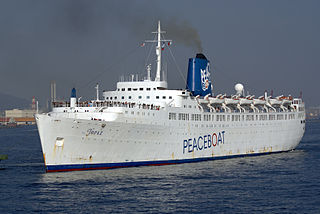
RMS Empress of Britain was a transatlantic ocean liner built by Fairfield Shipbuilding at Govan on the Clyde in Scotland in 1955-1956 for Canadian Pacific Steamships (CP). This ship — the third of three CP vessels to be named Empress of Britain — regularly traversed the trans-Atlantic route between Canada and Europe until 1964, completing 123 voyages under the Canadian Pacific flag.

SS Adriatic was the first of two White Star Line ocean liners to carry the name Adriatic. The White Star Line's first four steamships, the met with great success in the trans-Atlantic market, and the line decided to build two more. The first of these was the SS Adriatic, which was built by Harland and Wolff and launched on 17 October 1871; the second was the Celtic.
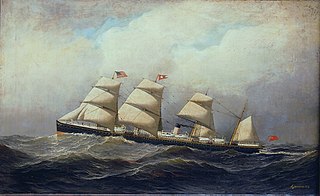
SS Baltic was an ocean liner owned and operated by the White Star Line. Baltic was one of the first four ships ordered by White Star from shipbuilders Harland and Wolff after Thomas Ismay bought the company, and the third of the ships to be delivered.
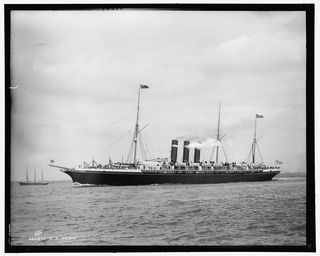
City of Paris, was a British-built passenger liner of the Inman Line that held the Blue Riband as the fastest ship on the north Atlantic route from 1889 to 1891 and again from 1892 to 1893. A sister ship of the City of New York and a rival of the White Star Line Teutonic and Majestic, she proved to be the quickest of the pre-Campania twin-screw express liners. In 1893, she was renamed Paris and transferred to US registry when the Inman Line was merged into the American Line. She and her sister were paired with the new American built St Louis and St Paul to form one of the premier Atlantic services. Paris served the US Navy as the auxiliary cruiser USS Yale during the Spanish–American War and is remembered for slipping into the harbor at San Juan, Puerto Rico, under the Spanish guns of Morro Castle. After Paris returned to commercial service, she was seriously damaged in 1899 when she grounded on The Manacles off the British coast. Rebuilt and renamed Philadelphia, she sailed for the American Line until requisitioned again during World War I as the transport Harrisburg. After the war, she continued with the American Line until 1920 and was scrapped in 1923.
SS Champlain was a cabin class ocean liner built in 1932 for the French Line by Chantiers et Ateliers de Saint-Nazaire, Penhoët. She was sunk by a mine off La Pallice, France, in 1940—one of the earliest passenger ship losses of the Second World War.

SS The Emerald was a cruise ship owned by Louis Cruise Lines. She was built in 1958 by the Newport News Shipbuilding and Drydock company in Newport News, Virginia, United States, for the Grace Line, as the ocean liner Santa Rosa. Between 1992 and 1995, she sailed for Regency Cruises as Regent Rainbow and between 1997 and 2008, she sailed for Thomson Cruises as The Emerald. Before retiring in 2009, she was the last passenger ship built at a U.S. shipyard that was still in active service.
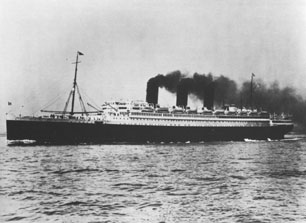
SS Paris was a French ocean liner built for the Compagnie Générale Transatlantique by Chantiers de l'Atlantique in Saint-Nazaire, France. Although Paris was laid down in 1913, her launching was delayed until 1916, and she was not completed until 1921, due to World War I. When Paris was finally completed, she was the largest liner under the French flag, at 34,569 tons. Although not so large as the Olympic-class or the Imperator-class and not intended to challenge the speed record of the Mauretania, the Paris, operated by the Cie Generale Transatlantique, was one of the finest liners put into service, at the time. She was 768 feet long, 86 feet beam and 60 feet deep. On 31 feet draught, she displaces 36,700 metric tons

SS Duchess of York was one of a class of four steam turbine ocean liners built in Glasgow in 1927–29 for Canadian Pacific Steamships Ltd's transatlantic service between Britain and Canada.

SS Tuscania was a luxury liner of the Anchor Line, a subsidiary of the Cunard Line and named after Tuscania, Italy. In 1918 the ship was torpedoed and sunk by the German U-boat UB-77 while transporting American troops to Europe with the loss of 210 lives.

RMS Sylvania was an ocean liner built in 1957 by John Brown & Co (Clydebank), in Glasgow, for the United Kingdom-based shipping company Cunard Line. She was the last Cunard Line vessel built specifically for transatlantic crossings. The ship was later heavily rebuilt as a cruise ship, and sailed under the names SS Fairwind, SS Sitmar Fairwind, SS Dawn Princess and SS Albatros before being scrapped in 2004. She was renamed SS Genoa for her last voyage.
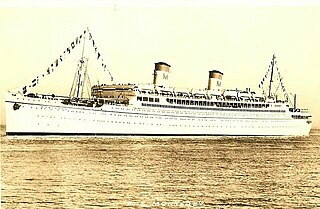
SS Monterey was a luxury ocean liner launched on 10 October 1931. The ship was completed April 1932 and is shown in registers as a 1932 ship. Monterey was the third of the four ships of the Matson Lines "White Fleet", which were designed by William Francis Gibbs and also included SS Malolo, SS Mariposa and SS Lurline. Monterey was identical to Mariposa and very similar to Lurline. During World War II Monterey was used as a troopship operated by Matson as agents of the War Shipping Administration (WSA). Monterey was a large, fast transport capable of sailing independently and was allocated to serving Army troop transport requirements. The ship was involved in an attack on a convoy near Cape Bougaroun.

SS California was a twin-screw steamer that D. and W. Henderson and Company of Glasgow built for the Anchor Line in 1907 as a replacement for the aging ocean liner Astoria, which had been in continuous service since 1884. She worked the Glasgow to New York transatlantic route and was sunk by the German submarine SM U-85 on 7 February 1917.
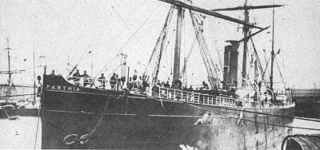
The SS Parthia (1870–1956) was an iron-hulled transatlantic ocean liner built for the Cunard Line by William Denny and Brothers in Dumbarton, Scotland. Her sister ships were the Abyssinia and Algeria. Unlike her two sisters, Parthia was smaller, built in a different shipyard and had a slightly different funnel arrangement. The Parthia was retired by Cunard in 1883 and sold to John Elder & Co., who subsequently transferred her to the Guion Line. After serving with the Guion Line and operating on trans-Pacific routes with the Canadian Pacific Railway Company, she was refitted and renamed Victoria.
Anchor Line was a Scottish merchant shipping company that was founded in 1855 and dissolved in 1980.
RMS Caledonia was a British ocean liner built by Alexander Stephen and Sons for the Anchor Line which was converted into an armed merchant cruiser during World War II.

SS Caledonia was a British ocean liner that was built in Scotland in 1905 and converted into a troop ship in 1914. She was sunk by a German U-boat in the Mediterranean in 1916.
















